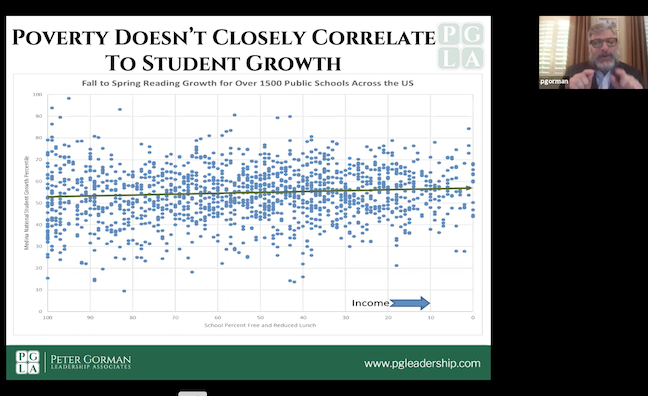
In opening the FETC closing keynote, Peter Gorman got right to talking about the elephant in the room.
That is: “In the United States, not all students are having a great experience,” he said as he shared achievement data.
“We have some real challenges for some students and there are some groups that are disproportionately in an environment where they are not achieving at the levels needed, and this is a problem that we must address at scale. But I am hopeful because all children can learn,” noted Gorman, who has more than 30 years of experience in education and business, including serving as Superintendent for Charlotte-Mecklenburg Schools.
Gorman is now superintendent in residence for the District Administration Leadership Institute and manager of its National Superintendents Academy.
Because data has shown that poverty doesn’t closely correlate with student growth, he said, “the challenge isn’t with our students. It’s an issue with us, with America, with the education we are providing and the support we are providing. We’ve got to work together to increase achievement at scale.”
Gorman is also co-author of the 2020 book, Leading a School District Requires Clarity, Context, and Candor: An Aligned System to Increase Student Achievement at Scale (LRP Publications, publisher of DA).
His call to action is an immediate one. “We’ve got to have urgency,” he said, showing a photo of a family eating dinner together. “We’ve got to make sure every day that when the referendum occurs at the kitchen table—and the referendum goes like this: ‘How was your day at school today?’—all students answer that question with ‘It was great!’ and they can share what they learned. Right now we don’t have that question with an answer of a yes at every kitchen table.”
Many school districts do great work, but in isolation, he said. Individuals come to work but at the end of the day in the parking lot might say to a colleague “I did this today. What did you do?”
He showed a commercial of a man clearing snow from his car as an example of work that is out of alignment. The man did a good job in his work, but as he clicks his keys to unlock his door he sees that he cleared off the wrong car. He did good work but he’s desperately out of alignment.
 In aligned school systems, each person’s work combines with the work of another person, and you wind up with a 2 + 2 = 5 scenario.
In aligned school systems, each person’s work combines with the work of another person, and you wind up with a 2 + 2 = 5 scenario.
The best districts have a set of beliefs that are about student achievement. Alignment involves moving up from those beliefs, creating a related vision and mission, and theory of action, and then ensuring policies and the strategic plan are aligned to all of these areas.
From there, district leaders can ensure organizational structures, the budget, accountability systems and evaluations are also in alignment.
Technology’s role
Human capital, talent and leadership really help move the ball in effective school districts.
“I bet on people, not programs,” Gorman said. “But I bet on programs in the hands of the right people. If the technology you’re bringing in is not in the hands of an effective teacher who knows how to utilize it, it’s not going to be the workaround of an ineffective teacher. A highly effective teacher with a high-quality program, or product or service, can do unimaginable things for kids to help close achievement gaps to reach new levels.”
The highest-performing individuals, he added, must be provided with the tools that they need.
“If we have learned anything from COVID, it is that some of the transition we have had to make to digital, to distance learning, to utilizing LMSs, has shown we are saying and doing something are different things,” he said. “We had been saying we’d been using technology all along. We have realized in many ways that we were paying lip service to this. It was never an aligned part; it was on its own.”
Leaders of aligned school systems ask: “How is technology a part of the system in every element?”
Regarding ed tech, Gorman noted that students will use technology in real-world ways. “We have to support students, not as a special event type of thing,” he said. “We need to budget for it; it will become part of our vision and mission.”

